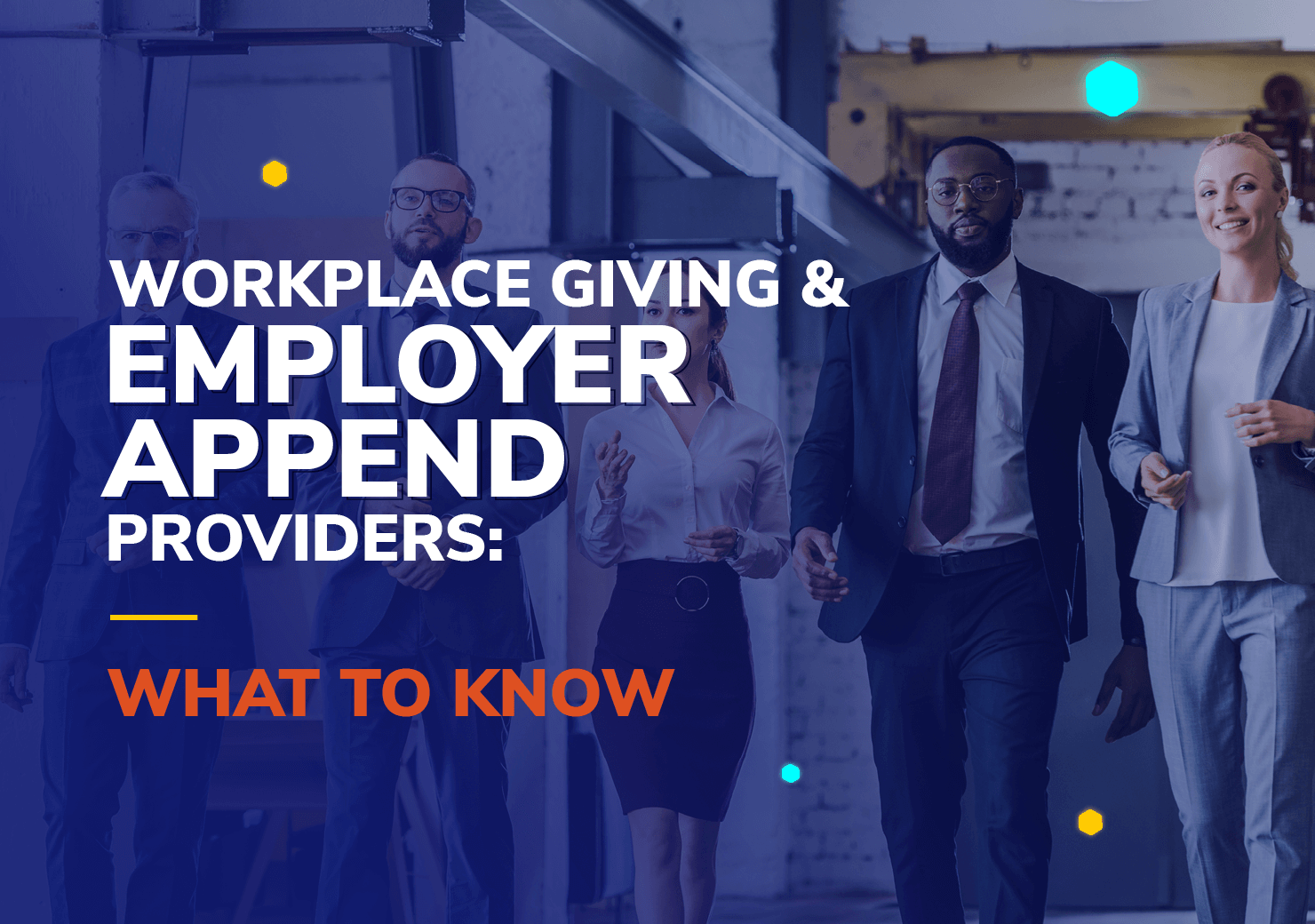Workplace Giving & Employer Append Providers: What to Know


Imagine launching a powerful workplace giving campaign, only to discover you don’t have employment information for the majority of your donors. That’s a problem many nonprofits face. With $4 to $7 billion left unclaimed annually in matching gifts alone, it’s clear that missed workplace giving opportunities often come down to one simple gap: not knowing where your donors work. Luckily, that’s where workplace giving and employer append providers come in.
When paired with a smart workplace giving strategy, appending employment data can directly lead to increased revenue, deeper donor engagement, and higher ROI on your outreach efforts.
But not all workplace giving and employer append services are created equal, and knowing what to look for can make a big difference. In this article, we’ll break down what you need to know about employer append providers and how this data fuels successful workplace giving. We’ll cover:
- What Is Workplace Giving?
- Why Employment Data Matters for Nonprofits
- The Basics of Employer Appends
- Choosing an Employer Append Provider: What to Look For
- Double the Donation vs. NPO Info: How They Stack Up
- Using Employer Appends to Increase Fundraising: 5 Tips
As more donors expect transparency and convenience from the organizations they support, nonprofits must meet the moment with targeted, data-driven outreach. Below, we’ll explore how workplace giving works, why employer appends are essential, and which provider can offer the best results for your mission. Let’s begin!
What Is Workplace Giving?
Workplace giving refers to a broad range of programs offered by employers to encourage and amplify charitable giving among their employees. These programs may include:
- Matching gifts: Companies match donations made by employees to eligible nonprofits, often doubling or tripling the gift.
- Volunteer grants: Employers donate funds based on the number of hours an employee volunteers with a nonprofit.
- Payroll deductions: Employees can make direct, regular contributions from their paychecks to support their chosen nonprofits.
- And more!
These corporate philanthropy initiatives are win-win: they empower employees to support causes they care about while helping nonprofits access otherwise untapped funding streams. But there’s a catch: employees have to know the programs exist, and nonprofits need to know where their donors work to help them take advantage of these opportunities.
Why Employment Data Matters for Nonprofits
Nonprofits collect all sorts of data on donors: names, addresses, giving history, and communication preferences, to mention a few. But employment data is often missing or outdated, making it difficult to unlock the full potential of workplace giving.
In other words, if you don’t know where your donors work, you can’t inform them about:
- Matching gift availability
- Volunteer grant eligibility
- Payroll giving program opportunities
- Specific corporate giving policies or deadlines
- Pre-filled forms or auto-submission tools
That missing data can translate to a significant amount of missed dollars.
Not to mention, employment data also enhances an organization’s segmentation and personalization efforts. If you know a donor works at a company with a generous matching gift policy, for example, you can tailor your outreach accordingly. If you see that a group of donors works for the same company, you can flag that as a potential corporate partnership or sponsorship opportunity.
This level of relevance improves engagement, increases conversion rates, and ultimately raises more money for your cause.
The Basics of Employer Appends
Employer appends are data services that help fill in the blanks in your donor database by matching existing supporter records with publicly or commercially available employment information. The process typically involves submitting a file of donor records to an append provider, who then matches those records to their employment data sources.
These services can return valuable details like:
- Current employer name
- Company contact information
- Matching gift eligibility
- Other workplace giving program availability
For nonprofits, employer appends are one of the most effective ways to build out missing employment data without relying solely on self-reported information from donors.
How Employer Appends Boost Workplace Giving Revenue
When nonprofits integrate employer appends into their fundraising strategies, they unlock significant growth potential in corporate giving revenue. Here’s how:
- Identify match-eligible donors: With employment data in hand, you can flag which donors are likely eligible for matching gift programs. This allows you to target them with relevant messaging at the right time.
- Activate volunteer grants at scale: Instead of waiting for volunteers to initiate a grant, you can proactively guide them through the process based on their employer’s guidelines.
- Grow support through payroll giving: Inform eligible corporate employees about their potential to give through payroll deduction programs. This allows you to grow recurring support and engage donors in the long run.
- Increase donor retention and lifetime value: Individuals are more likely to give again (and give more) when their support has a greater impact through donation matches or volunteer grants.
- Engage corporate partners more strategically: With insights into which companies your donors work for, you can approach employers with partnership opportunities backed by real data.
In short, the ROI of employer and workplace giving appends goes far beyond a data enhancement. It’s a revenue-generating tool that helps maximize every engagement with your cause.
Choosing an Employer and Workplace Giving Append Provider: What to Look For
Not all data providers offer the same value. To choose the right one for your organization, we recommend focusing your search on a few key criteria:
1. Data freshness and accuracy
Employment data is dynamic; people change jobs, switch industries, or move companies frequently. If a provider is pulling from stale sources or infrequently updated databases, the information you receive could be outdated before you even use it.
Look for a provider that regularly refreshes its data, ideally pulling from both public and proprietary sources to ensure accuracy. Current and trustworthy data is critical if you want to confidently identify supporters who are eligible for matching gifts, volunteer grants, or payroll giving programs right now.
2. Match rates and data completeness
One of the most important metrics to assess is match rate, or how many of your donor records the provider can successfully link to an employer. But it’s not just about quantity; completeness matters, too. A strong employer append result should include key workplace giving data points such as whether the employer offers matching gifts, grant programs, or payroll deductions, and what the eligibility criteria are.
The more complete the data, the more informed and personalized your outreach can be, ultimately increasing the likelihood of donor action and corporate funding.
3. Actionable insights for corporate philanthropy
While basic employment information is helpful, the actual value of an append comes from turning that data into fundraising results. That said, the best employer and workplace giving append providers go beyond simply telling you where someone works. They also connect that employer to real-time corporate giving opportunities, such as matching gift instructions, volunteer grant forms, submission deadlines, and company-specific policies.
These actionable insights eliminate guesswork and empower your team to immediately follow up with eligible donors using targeted, company-aware messaging.
4. Customer support and transparency
High-quality data is only part of the equation. Being able to understand and apply it is just as critical. That’s why customer support and transparency should weigh heavily in your decision-making process.
A good provider will offer clear explanations of how they generate their results, guidance on how to interpret the data, and support when integrating it into your broader fundraising strategy. Whether it’s answering questions, troubleshooting an import, or helping you segment your outreach, having an engaged partner can make all the difference in driving real results from your investment.
Double the Donation vs. NPO Info: How They Stack Up
When choosing an employer append provider, nonprofits often consider two of the most prominent names in the space: Double the Donation and NPO Info. While both services aim to help organizations identify where their donors work, there are notable differences in how each provider approaches data quality, usability, and actionable fundraising insights.
| Feature | Double the Donation | NPO Info |
|---|---|---|
| 🏢 Employer Data Accuracy | ✅ High accuracy, regularly refreshed data | ⚠️ Varies by record; refresh rate not specified |
| 📈 Match Rates | ✅ Industry-leading match rates | ⚠️ Match rates vary; less transparency |
| 💡 Workplace Giving Insights | ✅ Includes matching gift eligibility, volunteer grant access, payroll giving info, and more | ❌ Limited or no insights on workplace giving programs |
| 📞 Customer Support | ✅ Guided onboarding and ongoing support | ⚠️ Email support available; limited implementation help |
| 💰 Focus on Fundraising ROI | ✅ Built to drive revenue from corporate giving | ❌ Focused on data enrichment, not fundraising outcomes |
Double the Donation
Double the Donation is widely regarded as the industry leader for helping you turn employment data into actionable insights that directly support workplace giving strategies. They go beyond providing you with basic employment information. They actually translate uncovered employment information into comprehensive workplace giving data, such as matching gift, volunteer grant, and payroll giving eligibility, program guidelines, submission deadlines, and even direct access to workplace giving forms. This means nonprofits can immediately take action on the data they receive, using it to power workplace giving campaigns and automate associated outreach.
Another key differentiator is data freshness. Double the Donation continuously updates its workplace giving database to ensure the information provided is current and reliable. That means any employer information we uncover is then compared against the latest insights to ensure you have accurate results and feel confident in your next workplace giving action. This is critical in a landscape where changes are frequent, and stale data can lead to missed opportunities or wasted effort.
Not to mention, for organizations already using Double the Donation, employer appends can be seamlessly integrated to expand workplace giving eligibility and revenue potential without adding manual steps.
NPO Info
NPO Info, by contrast, offers a more traditional employment data append service. While it can return employer names and some basic matching gift information, it generally lacks the deep, actionable workplace giving insights that Double the Donation provides.
For organizations primarily looking to complete basic supporter records with employer data and limited workplace giving insights, NPO Info may be sufficient. However, nonprofits that want to translate employment data directly into revenue may find NPO Info’s offerings more limited in scope and actionability.
In short, while both services offer employment data append capabilities, Double the Donation stands out for nonprofits focused on maximizing workplace giving. With fresher data, more complete insights, and direct fundraising applications, Double the Donation provides the strategic edge needed to turn donor information into increased funding.
Using Employer Appends to Increase Fundraising: 5 Tips
Once you’ve received your employer append data, it’s time to put the information to work. Here’s how you can get the most out of your newly acquired workplace insights using expert-proven best practices:
1. Sync your data with workplace giving tools.
Once you’ve appended employment data to your donor records, the next step is to integrate that information into the workplace giving platforms your team already uses. These tools help identify opportunities across a range of programs, including matching gifts, volunteer grants, payroll giving, and more. Syncing your data append ensures that you can automate outreach, personalize follow-up, and guide donors through their specific giving options based on their employer’s programs.
Having current employment information embedded in your system makes it far easier to drive action and revenue across all types of corporate philanthropy.
2. Segment your communications.
Employer data opens the door to personalized, company-specific messaging that drives higher engagement. Once you know where your donors work and what workplace giving programs they’re eligible for, you can group supporters by employer, program type, or match amount. Then, tailor your emails to reflect that.
For example, you might send Apple employees an email outlining their $10,000 annual match cap and provide a link to submit a request, while Google employees get details about volunteering incentives. These personalized touches show donors you’ve done your homework and make it far easier for them to take action.
3. Educate your supporters.
Even the most generous donors often have no idea that their gift could be doubled (or even tripled) by their employer. That’s why ongoing education is key.
Make workplace giving a recurring theme in your communications. Add reminders to donation receipts, thank-you emails, and newsletters. Create a dedicated page on your website about matching gifts and volunteer grants. And don’t forget to mention employer giving in campaign launches and year-end appeals.
The more visible these opportunities are, the more likely donors will follow through. Employer appends help you make this education relevant by showing exactly which donors are eligible.
4. Track your ROI.
To fully understand the impact of employer data, make sure you’re tracking the revenue that enriching your profiles with this data helps generate. Monitor key performance metrics, such as total matching gift dollars received, the number of volunteer grant submissions, and any new corporate sponsors acquired through donor connections.
This data allows you to measure the return on your investment in appending services and justify future budget allocations. It can also help you identify patterns. For example, which employers are most responsive to outreach or which programs produce the most ROI, so you can refine your strategy over time.
5. Update regularly.
Employment data isn’t static. Supporters change jobs, retire, or take on new roles, and that means their eligibility for workplace giving programs changes, too. To keep your data fresh and your outreach relevant, consider re-appending your file on an annual or biannual basis.
Some nonprofits choose to align these updates with their annual giving campaigns or fiscal year planning to keep their data aligned with outreach goals. Maintaining clean, current records not only boosts accuracy but also keeps your donor engagement sharp and effective.
Wrapping Up & Additional Resources
Workplace giving is one of the most underutilized fundraising tools in the nonprofit sector, and employer appends are the key to unlocking its full potential. When you know where your donors work, you can empower them to make a greater impact through matching gifts, volunteer grants, and other employer-sponsored giving programs.
And while several providers offer employer append services, Double the Donation provides the most complete, actionable, and fundraising-focused solution available today. Their insights go beyond employment data, helping your team actually activate workplace giving opportunities, not just discover them.
If your organization is looking to increase corporate giving revenue and fill in the blanks in your supporter data, investing in employer appends is the smartest next step. Start turning unknowns into opportunities, and make every donor dollar go further.
Interested in reading more about workplace giving and employer appends? Check out these additional resources to continue learning:
- Expert Workplace Giving Strategies for Fundraising Teams. Grow your nonprofit’s workplace giving revenue with top strategies for fundraising teams! Explore expert-proven best practices for corporate and individual success.
- The Ultimate Guide to Employer Appends for Fundraisers. Find out everything you need to know about employer appends in this comprehensive guide. From the basics to advanced strategies, Double the Donation covers it all.
- Is an Employer Append Right for Your Nonprofit? How to Know. Wondering if an employer append is right for your team? Read this handy guide to help make the best decision for your fundraising organization.




